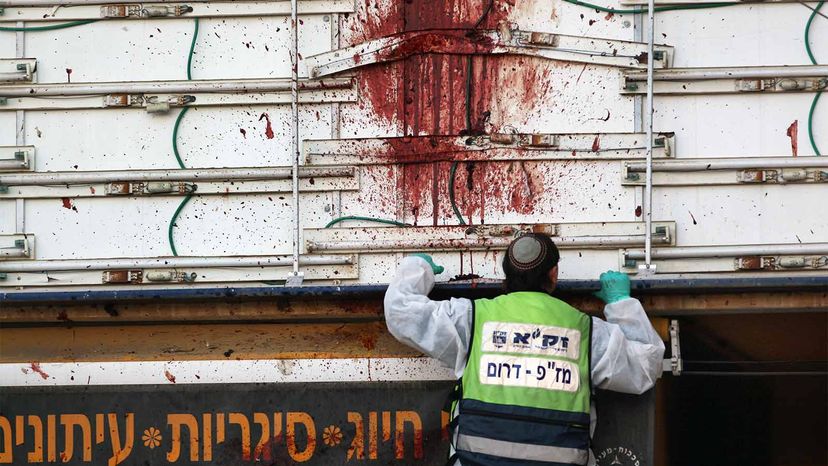Blood Spatter

Blood behaves not unlike spilled water droplets, and the speed at which the droplets travel when they strike a surface — known to analysts as a target — affects their shape. This speed, combined with angle and surface characteristics, also determines how far blood droplets skip or bounce after meeting a barrier.
One pattern of slow-moving blood, called "drips," occurs after an injury, and has a relatively large footprint of 0.16 inches (4 millimeters) or more. Drips, which result from blood dripping onto blood, can fall from a bleeding nose or wound, or a motionless, bloodied weapon or object. A moving object produces what's known as a cast-off pattern. Other low-velocity patterns include blood pooling around a victim's body and impressions left by bloody objects. This latter phenomenon, called a transfer, sometimes retains the shape of the object that made it [source: Wonder].
Advertisement
At the other end of the scale are the tiny droplets caused by blood traveling at high speeds. These are usually caused by gunshot wounds, but they can also result from explosions, power tools or high-speed machinery. These fast-moving drops leave stains measuring less than 0.04 inches (1 millimeter) across.
Bullet wounds can produce both back and front spatters. Back spatter, or blowback, refers to blood exiting the entrance wound in the direction opposite the impact [source: Dutelle]. Actually, thanks to Newton's Third Law of Motion, back spatter can result from other impacts and traumas as well.
Investigators dealing with such small drops must rule out other sources of blood spray, such as respiration or pinhole arterial pressure [source: Wonder]. Forward spatter, in the direction of the impact, occurs only in the case of an exit wound [source: Dutelle].
Between these extremes lies a range of medium-sized droplets. Typically measuring 0.04 to 0.16 inches (1 to 4 millimeters), they can be caused by a blunt object such as a bat or a fist, or can result from stabbing, cast-offs or even bloody coughs [sources: Dutelle, Wonder].
Several factors complicate their analysis. For example, during a beating or stabbing, arterial damage can cause the subject to bleed faster or to spurt blood, the latter creating what's known as a projected pattern [source: Dutelle].
In addition to spatters, analysts look for voids, aka blockages. In the case of a high-density spatter, these gaps in the pattern indicate that something in the way, potentially the assailant, caught some of the victim's blowback.
Drop size is only one aspect used in analyzing blood spatters. Next, we'll look at the shapes of spatters and how analysts use strings, trigonometric functions and computer programs to map out a blood-spattered crime scene.